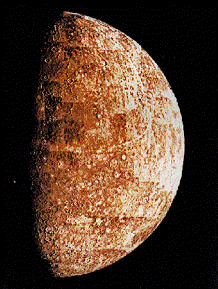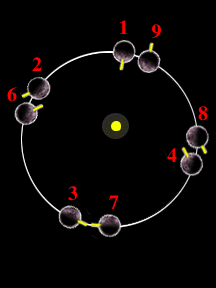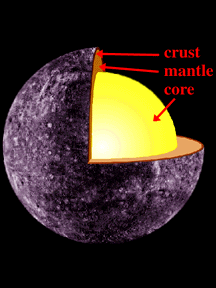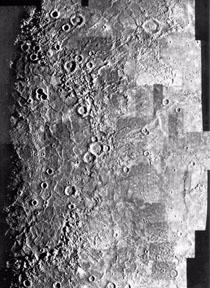This is a false color image of a mosaic of Mercury.
Click on image for full size
Courtesy of NASA.
Observations of Mercury from Earth
Before the Mariner 10 mission of Mercury, it was very difficult to
see any markings on the surface of the planet from Earth. This image
shows a view of Mercury obtained from a telescope on Earth. The first
attempts to find out the day length of the planet found an 88 earth-day
rotation period, equal to the orbital period, or year length. It was only in the
1960s, when a radar technique allowed the rotation rate to be
determined, we found that Mercury spins on its axis every 59
Earth days. But the length of a day on Mercury is about three times
this. To find out why, click the link below.
You might also be interested in:

What types of instructional experiences help K-8 students learn science with understanding? What do science educators teachers, teacher leaders, science specialists, professional development staff, curriculum designers, school administrators need to know to create and support such experiences?
...more
Mercury's orbit is so close to the Sun that it is difficult to see from the ground. This explains why some early astronomers never saw the planet. Viewed from Earth, Mercury is never far from the Sun
...more
It takes Mercury about 59 Earth days to spin once on its axis (the rotation period), and about 88 Earth days to complete one orbit about the Sun. However, the length of the day on Mercury (sunrise to
...more
Before the Mariner 10 mission of Mercury, it was very difficult to see any markings on the surface of the planet from Earth. This image shows a view of Mercury obtained from a telescope on Earth. The
...more
Mercury, like the other planets, is believed to have formed in the earliest stage of the evolution of the solar system as dust came together to form even larger clumps and eventually small planets or
...more
Mercury, the innermost planet of the solar system, is a little bigger than the Earth's Moon. The surface of the planet is covered with craters, like the Moon, but temperatures there can reach over 80
...more
Mercury has a radius of 2439 km (1524 mi), and the metallic iron-nickel core is believed to make up about 75% of this distance. Measurements of the planet's magnetic field made by Mariner 10 as it flew
...more
The Caloris Basin is the largest feature on the surface of Mercury. This crater was formed by the impact of a large meteorite in the early formation of the solar system. We only know what half of the
...more











